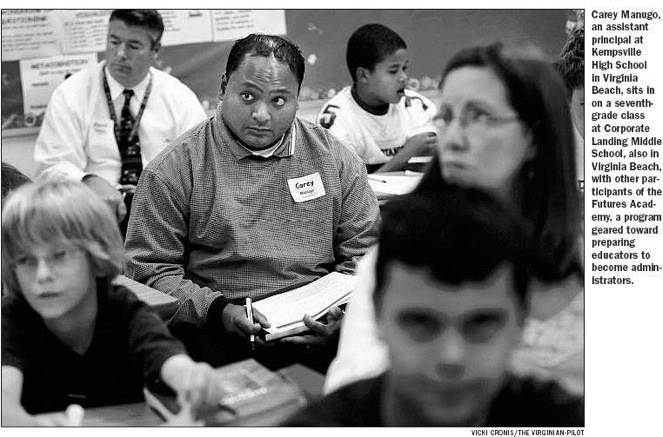Clips

BY LAUREN ROTH
THE VIRGINIAN-PILOT
OCT. 21, 2006
VIRGINIA BEACH — Larry Ames seeks out the black boys at his school every day to tap fists and chat.
Carey Manugo tells Filipino teachers to consider becoming administrators.
Both men – one black, one Asian – are graduates of a Virginia Beach public schools program that trains future principals.
Four school divisions in South Hampton Roads have similar programs. Each program helps train a more racially diverse pool of future principals, a group more like the student body.
“What better way to show children of different backgrounds you can be whatever you want to be as long as you do the work?” said LyVonnia Revels, part of the ninth Futures Academy class in Virginia Beach, which graduated 20 students Wednesday.
Of the 210 assistant principals and aspiring assistant principals who have completed the program since it began in 2002, about 26 percent have been black, Asian or Hispanic. That compares with 39 percent of the student body. Currently, fewer than two in 10 Beach school administrators are minorities.
The academy application process doesn’t consider race or gender.
“When you see someone has potential, you ask if he has thought of the Futures Academy or administrative leadership,” said Deputy Superintendent Sheila Magula. Changes at the top begin with a diverse staff, and that has meant hiring teachers from abroad, particularly the Philippines.
“When you have more staff with similar backgrounds to the kids, you create more knowledge on how to serve those kids,” said Pedro Noguera, a New York University sociology professor and author of “City Schools and the American Dream.”
He said white teachers can also learn those skills.
Todd Tarkenton, an assistant principal at Ocean Lakes High School, took to heart a Futures Academy session focusing on diversity. He sought out a group of black girls at his school to ask why they don’t participate more in student leadership.
“By me walking up to them and having that conversation, I hope that breaks down barriers ,” he said.
Tarkenton, who is white, said he doesn’t think the race of administrators matters, but understanding diversity does.
“If you have the most qualified individuals who understand the population and can relate, it shouldn’t matter,” he said.
Manugo, an assistant principal at Kempsville High School, said mentoring helped him consider administration.
“I saw that the teaching ranks weren’t as representative as the student body,” he said.
Ames, part of the first wave of minorities to attend the Futures Academy in 2002, is now principal of Seatack Elementary School.
“Sometimes kids need to see someone they can relate to,” he said. Though Ames greets all of his students every day, he pays special attention to the young men.
“I understand where they come from,” he said.
Since the academy began, four of the 16 principals hired from among its graduates have been black or Hispanic, said Olwen Herron, director of the office of organizational development. Among the 39 assistant principals hired from the academy, 16 are black, Hispanic or Asian.
Revels said the school system has come a long way in the 20 years since she was hired.
“Back in 1986, they were talking about diversity,” she said. “The staff makeup has changed. There’s been an earnest effort seeking diversity in the classroom and among classified staff, and not just by race.”
Lauren Roth, (757) 222-5133, lauren.roth@pilotoline.com

